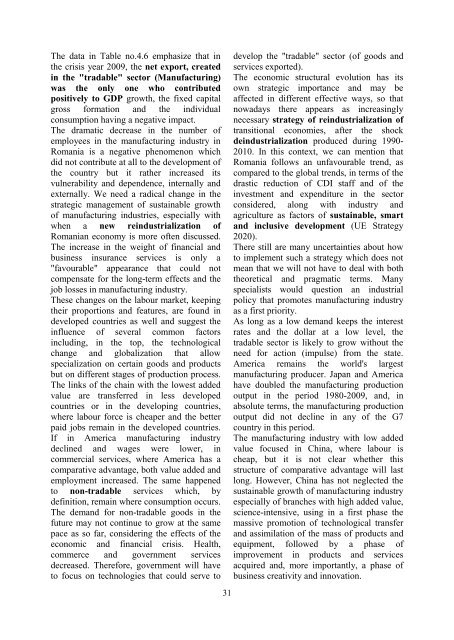Selected papers~ SPECIAL EDITION - Index of
Selected papers~ SPECIAL EDITION - Index of
Selected papers~ SPECIAL EDITION - Index of
Create successful ePaper yourself
Turn your PDF publications into a flip-book with our unique Google optimized e-Paper software.
The data in Table no.4.6 emphasize that in<br />
the crisis year 2009, the net export, created<br />
in the "tradable" sector (Manufacturing)<br />
was the only one who contributed<br />
positively to GDP growth, the fixed capital<br />
gross formation and the individual<br />
consumption having a negative impact.<br />
The dramatic decrease in the number <strong>of</strong><br />
employees in the manufacturing industry in<br />
Romania is a negative phenomenon which<br />
did not contribute at all to the development <strong>of</strong><br />
the country but it rather increased its<br />
vulnerability and dependence, internally and<br />
externally. We need a radical change in the<br />
strategic management <strong>of</strong> sustainable growth<br />
<strong>of</strong> manufacturing industries, especially with<br />
when a new reindustrialization <strong>of</strong><br />
Romanian economy is more <strong>of</strong>ten discussed.<br />
The increase in the weight <strong>of</strong> financial and<br />
business insurance services is only a<br />
"favourable" appearance that could not<br />
compensate for the long-term effects and the<br />
job losses in manufacturing industry.<br />
These changes on the labour market, keeping<br />
their proportions and features, are found in<br />
developed countries as well and suggest the<br />
influence <strong>of</strong> several common factors<br />
including, in the top, the technological<br />
change and globalization that allow<br />
specialization on certain goods and products<br />
but on different stages <strong>of</strong> production process.<br />
The links <strong>of</strong> the chain with the lowest added<br />
value are transferred in less developed<br />
countries or in the developing countries,<br />
where labour force is cheaper and the better<br />
paid jobs remain in the developed countries.<br />
If in America manufacturing industry<br />
declined and wages were lower, in<br />
commercial services, where America has a<br />
comparative advantage, both value added and<br />
employment increased. The same happened<br />
to non-tradable services which, by<br />
definition, remain where consumption occurs.<br />
The demand for non-tradable goods in the<br />
future may not continue to grow at the same<br />
pace as so far, considering the effects <strong>of</strong> the<br />
economic and financial crisis. Health,<br />
commerce and government services<br />
decreased. Therefore, government will have<br />
to focus on technologies that could serve to<br />
31<br />
develop the "tradable" sector (<strong>of</strong> goods and<br />
services exported).<br />
The economic structural evolution has its<br />
own strategic importance and may be<br />
affected in different effective ways, so that<br />
nowadays there appears as increasingly<br />
necessary strategy <strong>of</strong> reindustrialization <strong>of</strong><br />
transitional economies, after the shock<br />
deindustrialization produced during 1990-<br />
2010. In this context, we can mention that<br />
Romania follows an unfavourable trend, as<br />
compared to the global trends, in terms <strong>of</strong> the<br />
drastic reduction <strong>of</strong> CDI staff and <strong>of</strong> the<br />
investment and expenditure in the sector<br />
considered, along with industry and<br />
agriculture as factors <strong>of</strong> sustainable, smart<br />
and inclusive development (UE Strategy<br />
2020).<br />
There still are many uncertainties about how<br />
to implement such a strategy which does not<br />
mean that we will not have to deal with both<br />
theoretical and pragmatic terms. Many<br />
specialists would question an industrial<br />
policy that promotes manufacturing industry<br />
as a first priority.<br />
As long as a low demand keeps the interest<br />
rates and the dollar at a low level, the<br />
tradable sector is likely to grow without the<br />
need for action (impulse) from the state.<br />
America remains the world's largest<br />
manufacturing producer. Japan and America<br />
have doubled the manufacturing production<br />
output in the period 1980-2009, and, in<br />
absolute terms, the manufacturing production<br />
output did not decline in any <strong>of</strong> the G7<br />
country in this period.<br />
The manufacturing industry with low added<br />
value focused in China, where labour is<br />
cheap, but it is not clear whether this<br />
structure <strong>of</strong> comparative advantage will last<br />
long. However, China has not neglected the<br />
sustainable growth <strong>of</strong> manufacturing industry<br />
especially <strong>of</strong> branches with high added value,<br />
science-intensive, using in a first phase the<br />
massive promotion <strong>of</strong> technological transfer<br />
and assimilation <strong>of</strong> the mass <strong>of</strong> products and<br />
equipment, followed by a phase <strong>of</strong><br />
improvement in products and services<br />
acquired and, more importantly, a phase <strong>of</strong><br />
business creativity and innovation.


